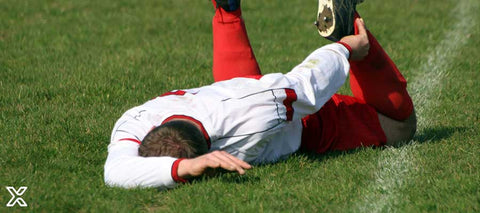Blog: Why do some athletes choke more than others?
In today’s blog, we’ll consider the following:
The Big Gag
Time Travel
Choking and Injuries
Prevention and Performance

The Big Gag
In sports, it’s called choking, panicking, freezing up, the yips, and even running for cover. The ‘Big Gag’ is the failure of an athlete to perform as anticipated or expected. It can occur in a game or tournament in which the athlete is strongly favored to win, or in an instance where they have a large lead that they squander in the late stages of the event. It’s one of the worst feelings an athlete can experience.
It's that sudden, unpleasant, overwhelming sensation, that debilitates the athlete's performance and ultimately leads to a loss that should've never occurred. Choking can cost an athlete a match, a championship, a title, or even a gold medal. It can also leave mental scars that can compromise future competitions.
Most all athletes succumb to these situations at one time or another. But why do some athletes choke more often than others? The ‘greatest of all time’ athletes like Tiger Woods, Wayne Gretzky, Michael Jordan, Roger Federer, Martina Navratilova, or Joe Montana, seem to always sidestep the ‘Big Gag’. It seems unthinkable to suggest that those historical icons like Babe Didrikson, Babe Ruth, or Ty Cobb could have ever been tripped up by the ‘Big Gag’.
The truth is that anyone – and I mean anyone – who has competed at a high level has choked somewhere along the line. We’ve seen it in every sport, in both men and women, individuals and teams. Even Chess Grandmasters like Garry Kasparov, Bobby Fischer, or Magnus Carlsen have had to overcome this affliction. The difference is that all of the elite champions know how to quell the ‘Big Gag’.
Choking issues can be complex and multifaceted. However, over my coaching career, I believe the main reason most athletes choke is due to ‘thinking too much’. Athletes choke when they over-analyze actions they usually perform naturally. When athletes find themselves thinking about processes that normally come automatically, this switches their focus away from the ‘now’ of the performance and gets mired back in ‘past’ mistakes or jumps ahead to the ‘future’ prospect of winning or losing.
When we allow our minds to float around from past to present and then off into the future, we set the stage for focus drift and, potentially, the ‘Big Gag’. Think of this as balancing along the tightrope of a timeline. When you spread your thoughts out across a wide spectrum, your concentration is dispersed. Your equilibrium is distorted. You are mentally wandering. Your highly concentrated state of ‘Flow’ or ‘Zone’ is completely disrupted. Being in the ‘Zone means you are in the present moment, intently and intentionally absorbed in the task at hand. Your tightrope is an easy stroll.

Time Travel
Let’s take a quick trip onto the tennis court for an example of how time travel and choking are interrelated.
Linear Time, The Past
In the middle of a match, you quickly lose 3 points in a row. This situation causes your mind to meander back down linear time into the past – as you think about those last 3 points. You may say to yourself as you ‘re-live’ those points or the feelings they conjure: “This is the worst I have ever played.” or, “My teammates just saw me miss that sitter.” These kinds of ‘living-in-the-past’ statements are like dragging a ball and chain around with you while you try to play. Allowing this baggage to keep you in the past is one of the most effective ways to get bogged down and guarantee low-level performance.

Linear Time, The Future
In your match, you’re ahead 4-3. You think to yourself, “I am going to break serve to go up 5-3. And then, I’ll serve out the set.” You are moving along linear time into the future. This focus diversion could likely cause you to lose the set. While you were busy future-thinking and planning the outcome, your opponent is focused and ready to take the set from you.
In fact, sometimes this ‘future’ slips and its inevitable outcome pulls you back into analyzing the past. You’re whipsawed forward and backward along linear time and continuing to choke all along the way. This cycling of past and future will have you running left, right, back, and forth, but you’ll be unable to move through it.
Linear Time, The Present
In this space, you are laser-focused. No clutter, no conversations going on in your head, and no distractions. You are in the ‘Flow’ or ‘Zone’. The very nature of being in the ‘Zone’ requires you to not consciously think about what it is you’re doing — instead, you’re just doing it. No time for choking because you are intently focused entirely on the ball. This is like the magnifying glass that focuses sunlight on one single point. It’s how you catch fire! This is where you want to be as much as possible.
It's been proven by research that in order to reach ‘Flow’ state, you must eliminate all external distractions. Every time you get pulled out of your focus you'll be taken further away from ‘Flow’.
When we take a wide spectrum view and flounder around in the past or future, we lose personal power. Our energy is flowing out to multiple points across linear time. When we drill into the present moment, all of our energy is honed down to the nucleus of the task at hand. This is the place that optimal performance resides.
Choking and Injuries
Can choking lead to injuries? I believe the answer is definitely yes. I have played against high-energy players, those who seem to be a little over-wound. I can feel their tension even in the warm-up. Their state of play seems reactive rather than proactive. As a result, they burn up more energy and fatigue faster. Competing in this state of tense energy will affect biomechanics. Usually, this leads to off-balance footing and posture.
This kind of tension will cause a higher level of stress both physically and mentally. When you are tense and unsteady, your body requires you to make many smaller quick adjustments. This is a great way to pull or strain muscles. Also, when you tense up, you tend to sweat more. Losing more body fluids creates tightness in your muscles. I believe uptight players are more prone to injuries.

Competitors who can stay in the present moment are proactive players. Being less tense, ‘Zone’ players tend to be much smoother in their movements. They burn less energy, and their endurance lengthens. Their level of hydration can be maintained easier because they are not sweating as much as the tenser player. They are not burning through nervous energy. By having a calmer, focused mind they can conserve energy. They can and do go the distance.
When you are tense or choking, you are not at optimal performance. You may have developed a habit of choking or a pattern of allowing yourself to be easily pulled out of the ‘Zone’. You can replace this habit of choking with the habit of performing in high-pressure situations.
Prevention and Performance
Here are a few tips for reducing tension and potential choking.
- On the tennis court if your doubles partner is tightening up, try a goofy joke. Making someone laugh achieves two powerful things. First, it pulls them right into the present moment. Second, it relaxes their body. Players that are happy and relaxed are extremely tough to play against. Biomechanics also become much more fluid when you are relaxed. This is a simple technique and makes any game more fun.
- If you’re playing singles and start to feel the choke, change things up. If you are a baseline player, try to serve and volley or hit a return and attack. Going on the offensive or ‘fight’ mode will quickly bring your focus back. You may need to do this for a few points, and you’ll see the tenseness subside as you ease back into the ‘Zone’. Simple and effective.
- I’ve said this before: Where your eyes go, your mind follows. Keep your eyes down on your court. If you are looking off at squirrels in a nearby tree, your opponent has full control of the court. You are now playing against your opponent, yourself and even the squirrels. Bring your laser focus back with eyes on the court. Pull your attention to the present moment – right here, right now, all in! This should be your mantra whenever you feel yourself beginning to wander.
Very few players dedicate much attention or training to the mental aspects of the game. This is great news for you if you can become one of the few who adapt and utilize these techniques. Regardless of your sport, the stronger your mind, the further you can go in your chosen event. The stronger your mind, the higher your pain tolerance.
The stronger your mind, the greater the advantage you will have over your competitors. The stronger your mind, the more consistent you will be. The stronger your mind, the more time you spend in the ‘Zone’. You can “Own the Zone”.
How do you neural-cultivate a strong mind? Here are a couple of ways to turn a mushy scattered mind into a steel trap.

- Practice mindfulness. It’s astounding how many top athletes miss this. I can tell you from personal experience that Navy Seals, Special Forces, military snipers have remarkably powerful levels of concentration. These elites understand that mindfulness training changes brain chemistry and is mandatory for success. There are lots of mindfulness techniques available. Try several and pick the one that works for you.
- Train your brain. Find a friend and start playing chess. Again, from personal experience, the act of sitting down and intently focusing on a chess game for 30-60 minutes takes a high level of deep concentration. It’s great training. Your concentration will quickly improve. If you have kids, turn off all the electronic toys (that can ruin a child’s concentration) and play some chess.

- A couple of weeks ago I wrote about Mental Meltdowns and offered S.A.R.A.H. as a tool. You may wish to go back and refresh on the Mental Meltdowns blog.
Take those chokes and turn them into clutch performance. Until next week my friends, be well. Remember you are invited to reach out to blog@bodyhelix.com with suggestions or questions.
Have a thoughtful day,
Coach Fred



